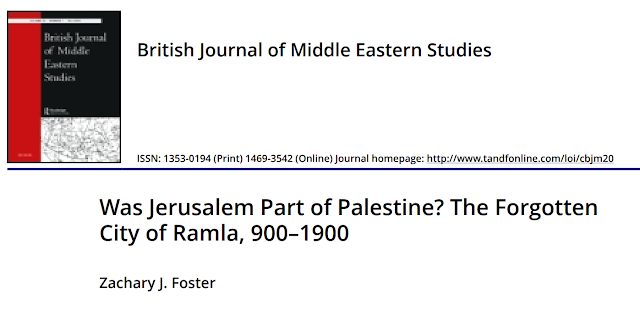
Here is the abstract of the academic article “Was Jerusalem Part of Palestine? The Forgotten City of Ramla, 900–1900” by Zachary J. Foster of Princeton University, published in the British Journal of Middle Eastern Studies in 2016:
When the Muslims conquered the Levant in the seventh century they at times changed the meaning of ‘Palestine’. They preserved its erstwhile sense as a region but also came to see Palestine as synonymous with the city of Ramla. From the tenth to the early twentieth century, dozens of Muslim exegetes, travellers and chroniclers explained that Ramla and Palestine were the same place. Others thought Palestine was a small region based around Ramla, one that did not include Jerusalem, or that Palestine had much more to do with Ramla than it did Jerusalem. The association had much to do with the cultural tendency in the Arab Middle East to conflate cities and regions as well as the critical role Ramla played in Palestine for much of its history: it served as the capital of the District of Palestine for more than three centuries, its economic hub for many more and its imagined geographical centre up until the early nineteenth century.
The article brings large amounts of evidence from Arab geographers and writers that what they considered “Palestine” was really Ramla or the region around it, and Jerusalem was a completely separate place.
Most cities never came to mean the same thing as their parent regions. But Ramla was not like most cities. Ramla become the seat of the most powerful empire in the world when the seventh-century Umayyad Caliph, Sulayman ‘Abd al-Malik (d.717) moved the seat of Islamic power from Damascus to Ramla. Soon enough, the city emerged as the political, geographic and economic centre of the District of Palestine during the Umayyad (661–750) and most of the Abbasid (750–1258) periods, for it lay at the crossroads of the key trading routes within the District of Palestine as well as the route connecting Damascus and Cairo. Although a massive earthquake in 1068 left some 15,000 people dead and the city in total ruins, Ramla recovered during the Crusader (1095–1291), Fatimid (909–1171) and Ayyubid (1171–1260) periods and remained the most important regional trading hub well into the Mamluk period (1250–1517). The town recorded steady population growth even after the Ottoman conquest in the early sixteenth century. (Jerusalem, by comparison, was a small and sleepy town for most of Islamic history. It had never been located on any major trading routes and its defensive walls were destroyed by an Ayyubid ruler in the early thirteenth century and only rebuilt in the 1530s by Suleiman ‘the Magnificent’.) And so even though Ramla’s population size, economic prosperity and political relevance diminished significantly from the late sixteenth century onwards, names have never been so easy to change. And so the city continued to be associated with Palestine; indeed, it continued to be known as Palestine as late as the eighteenth century if not later.
The Persian traveller Nasr Khusraw (d.1088) was the very first Muslim to say it explicitly. ‘The city of Ramla is called Palestine in both Sham and the Maghreb’, he wrote…
Soon enough, a slew of other writers across the lands of Islam embraced the nickname. The Andalusian geographer and historian al-Bakri (d.1094) noted that Ramla was known as Palestine; the high official in Mamluk Syria Ibn Fadl Allah al-‘Umari (d.1349) claimed that Filastin was also called Ramla in his definition of the Holy Land and commented elsewhere that Sulayman bin ‘Abd al-Malik bin Marwan (d.717) founded the city (madina) of Filastin; the famous Moroccan traveller Ibn Battuta (d.1369) also explained after his visit to Jerusalem and Ashkelon that he ‘traveled to the city of Ramla (madinat al-Ramla), which is Filastin (wa hiyya Filastin)’.
…But we have more explicit evidence that Palestine may have been considered a small region based around Ramla, one that did not include Jerusalem. Consider that the great historian al-Waqidi (d.822) consistently listed Jerusalem and the Land of Palestine separately in his account of the conquest of the Levant as if they were separate places. …
Similarly, a number of other Muslims from the thirteenth to the sixteenth century, including the famous biographer Ibn Khallikan (d.1282), Egyptian historian Ibn al-Furat (d.1405) and the Jerusalemite scholar and judge al-Din al-‘Ulaymi (d.1522), described the Kingdom of the Kurdish Ayyubid Sultan al-Mu‘azzam in the early thirteenth century as ‘expansive, from Homs to al-‘Arish, including the Islamic coasts, bilad al-Ghawr, Palestine and Jerusalem’. In this instance, there is no reason to assume that these writers meant Ramla only when they wrote Palestine, as this list included both cities and regions, leaving us with the impression that Palestine may have been considered a region based around Ramla that did not include Jerusalem.
Jerusalem was not even a part of “historic Palestine.” It was Christian pilgrims who consistently associated Jerusalem as the most important city of what Christians considered Palestine, and that idea eventually influenced Muslims.
Finally, Foster notes that Palestinians consciously wanted to change history to de-emphasize Ramla and emphasize Jerusalem in the 20th century for purely political reasons:
In other cases there may have been wilful intent to delete Ramla from memory. The historian Muhammad al-Husayni wrote in his 1946 history book about Palestine that ‘we have chosen to focus on Jerusalem (Bayt al-Maqdis) because it has been, and remains, the political and religious capital of this Arab country since the Arabs and Muslims first arrived, save for a brief moment (burha wajiza) in which it was transferred to Ramla’. Whether or not we define the three and a half centuries that Ramla was the political capital of Palestine as brief, or the seven or eight centuries that Ramla was the most important regional economic hub as ephemeral, or the millennium of the linguistic and cultural role that Ramla played in Palestine as fleeting, al-Husayni probably wanted us to believe in Jerusalem’s time-immemorial importance and Ramla’s time immemorial irrelevance. But the record suggests that Ramla was a central part of Palestine’s history…
…And Jerusalem was not.
The claim that Jerusalem is the “eternal capital of Palestine” is complete fiction.
UPDATE: Israellycool found this article as well.
We have lots of ideas, but we need more resources to be even more effective. Please donate today to help get the message out and to help defend Israel.

Leave a Reply